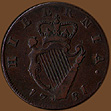Regal Irish Coppers
GEORGE II FARTHING ISSUES
obverse |
|
reverse |
| |||
Irish Farthing 1744 George II
Obverse: GEORGIUS . II . REX .
Reverse: HIBE RNIA . 17 44
Weight: 57.8 g (3.75 grams) Diameter: 21.6 mm
Comments: Following the unsuccessful attempt by William Woods to produce Hibernia farthings (and halfpence) during 1722-1724 under George I, no official Irish farthings were minted for over a decade. It was George II who revived the Irish farthing in 1737, minting I rish farthings dated 1737-1738, 1744 and 1760. There were no additional issues until the George III Irish farthings of 1806 (with a few proof 1805 examples). George II coins dated 1745 or earlier have the legend GEORGIUS; in 1746 this was changed to GEORGIVS. As no farthings were minted in 1745 (neither English nor Irish) the 1744 issue was the final farthing issue with the U in the legend. Interestingly, the portrait of George II was modified on English regal coppers in 1739 to what is sometime called the second or older bust, however the royal portrait was not changed on Irish coppers until the 1760 issue.
Provenance: Donated to Notre Dame in 1887 as part of a 2,300 item coin collection (see: The Notre Dame Scholastic, vol. 21 (September 1887) 45.
obverse |
|
reverse |
| |||
Irish Farthing 1760 George II
Obverse: GEORGIVS . II . REX .
Reverse: HIBE RNIA . 17 60
Weight: 59.7 g (3.89 grams) Diameter: 21.57 mm
Comments: This is an example from the last year royal Irish farthings were issued during the American colonial era. It is the first and only Irish farthing issue to use the V rather than the U in GEORGIVS and is the only issue to use the second or older bust of George II. No royal Irish farthing had been issued since 1744 and no royal Irish halfpenny since 1755. The additional coppers were anxiously awaited but unfortunately the 1760 issue of farthing and halfpennny did not arrive in Ireland until 1762. It has been speculated this was partly due to the death of George II in October of 1760. Because of the need for small change the Voce Populi coppers were minted in Dublin during 1760.
Although this example is well worn it is slightly heavier than the much better preserved example of the 1744 Irish farthing cataloged above. This is mentioned to show significant weight difference is not usually due to circulation and coin wear.
Provenance: Donated to Notre Dame in 1887 as part of a 2,300 item coin collection (see: The Notre Dame Scholastic, vol. 21 (September 1887) 45.
GEORGE III HALFPENCE ISSUES
obverse |
|
reverse |
| |||
Irish Halfpenny 1781 George III
Obverse: GEORGIVS . III . REX .
Reverse: HIBERNIA . 17 81
Weight: 140.3 g (9.09 grams) Diameter: 27.8 mm
Comments: Although George III did not mint any royal British halfpence between 1775 and 1799 regal Irish coppers were produced in 1774-1776 and 1781-1782 and several found their way to America. This example is within the minimum 140 grain weight range for regal issues. An example of this coin was found in the Philadelphia highway hoard.
Provenance: Donated to Notre Dame in 1887 as part of a 2,300 item coin collection (see: The Notre Dame Scholastic, vol. 21 (September 1887) 45.
| Regal Irish Coppers: p 1. | Section Contents | Counterfeit British Coppers: p. 1 |





